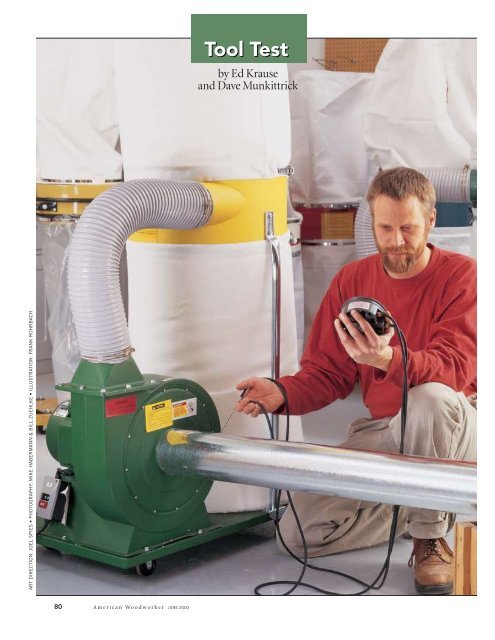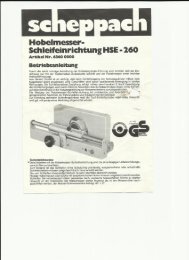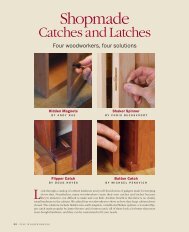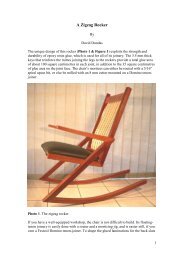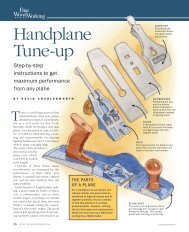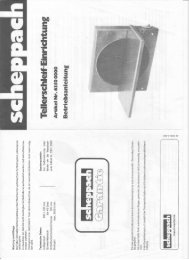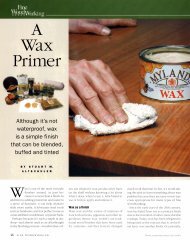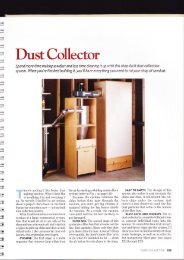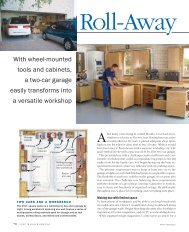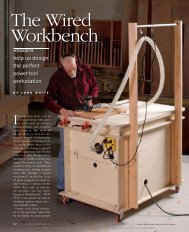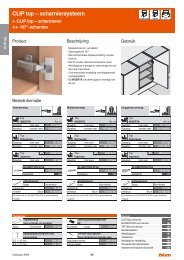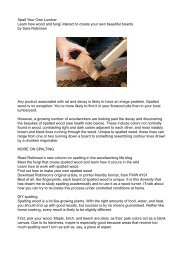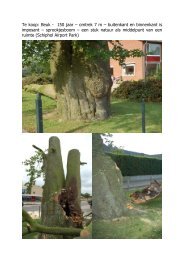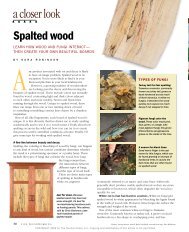AW80 TT Dust Collection
AW80 TT Dust Collection
AW80 TT Dust Collection
You also want an ePaper? Increase the reach of your titles
YUMPU automatically turns print PDFs into web optimized ePapers that Google loves.
Tool Test<br />
by Ed Krause<br />
and Dave Munkittrick<br />
ART DIRECTION: JOEL SPIES • PHOTOGRAPHY: MIKE HABERMANN & BILL ZUEHLKE • ILLUSTRATION: FRANK ROHRBACH<br />
80 American Woodworker JUNE 2000
CONTROL<br />
DUST<br />
SPECIAL ISSUE<br />
Wood dust is a health hazard, and<br />
the worst dust is the stuff you<br />
can’t see. <strong>Dust</strong> collectors seem like an<br />
easy answer to the<br />
problem. But do<br />
they do the job<br />
Most of the collectors<br />
we tested<br />
collected chips<br />
just fine, but<br />
instead of collecting<br />
the fine dust,<br />
most of them actually emitted it! We’ll<br />
tell you which collectors made the<br />
grade at collecting dust, and why. We’ll<br />
also show what can be done to transform<br />
a dust spewer into an effective<br />
dust collector.<br />
There are a lot of dust collectors out<br />
there. We limited this test to machines<br />
most likely to be used in a small shop—<br />
1- to 2-hp models costing less than<br />
$1,000.<br />
We examined two crucial aspects of<br />
dust collection: 1. How well the machines<br />
pull in dust and chips at the source (air<br />
volume as measured in cubic feet per<br />
minute or cfm) and 2. How well the collectors<br />
contain the dust they collect.<br />
A PRESSURE GAUGE was<br />
used to determine the air flow<br />
performance of each machine in<br />
cubic feet per minute (cfm).<br />
for the Small Shop<br />
Only a few<br />
collect the most<br />
hazardous dust.<br />
CFM<br />
Our chart includes two cfm readings;<br />
“Max” cfm and “Under Load” cfm.<br />
To determine Max cfm we hooked up<br />
a 10-ft. section of<br />
maximum-diameter,<br />
smoothwalled<br />
duct to<br />
each machine<br />
and used clean<br />
bags.<br />
Under Load<br />
cfm represents<br />
the real-world performance you can<br />
expect when the collector is hooked up to<br />
a small central system with bags that have<br />
developed a dust cake. Some collectors<br />
performed much better than others under<br />
these conditions.<br />
The central system we set up for testing<br />
consisted of 20 ft. of maximum-diameter<br />
straight pipe, a 90-degree bend, all the<br />
appropriate step-downs and 6 ft. of 4-in.<br />
flex hose with a 90-degree bend. (We<br />
assumed the system would collect from<br />
one machine at a time.) A dust cake develops<br />
on all filters and bags as soon as they<br />
begin to collect dust. The dust cake actually<br />
improves filtering performance but it<br />
also cuts down on the airflow and thus the<br />
cfm of your machine. In addition to the<br />
effects of dust cake, the cfm performance<br />
of single-stage collectors drops another 20<br />
percent as the lower bag gets full. (This is<br />
not true of cyclones.)<br />
American Woodworker JUNE 2000 81
THE FILTER IS<br />
THE MAIN THING<br />
The collection bags of single-stage<br />
collectors are expected to do double<br />
duty as filters. Unfortunately,<br />
most collector bags are made from<br />
woven fabric which is not particularly<br />
good at capturing fine particles<br />
(Photo 1). The best bags are<br />
made from 16-ounce polyester felt<br />
which is a “rated” filter material<br />
designed to remove 99 percent of<br />
particles 1 micron or larger (Photo<br />
2). But, this rating only holds true<br />
if one square foot of felt is used for<br />
every 10 cfm of airflow. In other<br />
words; if your collector is pulling<br />
500 cfm, you need 50 sq. ft. of 16-<br />
ounce polyester felt. The Penn<br />
State machines come closest to<br />
this ideal by using felt for both the<br />
top and bottom bags (32 sq. ft. for<br />
the DC2-5 and 22 sq. ft. for the<br />
DC1B-XL). (Aftermarket bags<br />
designed to handle 500 cfm are<br />
available from Oneida Air Systems;<br />
see Sources, page 85 and<br />
Product Review page 88.)<br />
A few collectors get it half right<br />
with a felt top bag. But these collectors<br />
have a plastic bottom bag,<br />
which filters no air, leaks at the<br />
bag flange (see Photo 4) and is a<br />
nightmare to attach.<br />
Of all the collectors that come<br />
with a felt bag(s),only Felder and<br />
Penn State use double or triple<br />
stitching on all seams. The others<br />
used single stitching to attach the<br />
round piece at the top of the bag.<br />
Single stitching can be stressed by<br />
the air pressure in the bag and<br />
open up escape routes for the dustladen<br />
air. (See Sources, page 85,<br />
for suppliers of aftermarket bag<br />
upgrades with double stitching.)<br />
Oneida Air Systems cyclone collector<br />
is unique in that it uses a<br />
pleated filter cartridge instead of a<br />
bag. The cartridge is made of nonwoven,<br />
spun-bonded polyester<br />
that outperforms even 16-ounce<br />
polyester felt.<br />
BAG<br />
FLANGE<br />
FILTER /<br />
STORAGE BAG<br />
<strong>Dust</strong><br />
Collectors<br />
FILTER BAG<br />
INLET<br />
METAL DUCT<br />
IMPELLER<br />
HOUSING<br />
1-HP, SINGLE-STAGE COLLECTORS have<br />
smaller bags that require more frequent<br />
emptying. But their small size is an asset in a<br />
shop where floor space is at a premium.The<br />
impeller housing is connected directly to the<br />
bag flange via a short metal duct.We found<br />
this design to be far less prone to dust leaks<br />
than the larger 1-1/2-hp and 2-hp models<br />
with a flex-hose attachment. The 1-hp<br />
collectors perform best when connected<br />
directly to a machine.<br />
A TWO-STAGE CYCLONIC<br />
COLLECTOR employs a coneshaped<br />
canister to separate most of<br />
the debris before it reaches the<br />
impeller and filter. This makes<br />
removal of the dust and chips more<br />
efficient and convenient.<br />
Also, because the filter<br />
on a two-stage cyclone<br />
does not act as a<br />
container for chips,<br />
there is no subsequent<br />
drop in the cfm<br />
performance as the<br />
barrel fills with debris.<br />
IN A SINGLE-STAGE<br />
COLLECTOR the chips<br />
and dust travel through the<br />
impeller and accumulate in<br />
the bags, which double as a<br />
filter medium. One big<br />
drawback to single-stage<br />
collectors is the drop in cfm<br />
performance that occurs as<br />
the lower bag fills with chips<br />
and dust.<br />
EXTERNAL<br />
FILTER BAG<br />
(TYP.) FOR<br />
FINE DUST<br />
INLET<br />
FLEX HOSE<br />
FILTER BAG<br />
IMPELLER<br />
HOUSING<br />
INLET<br />
BARREL<br />
HOLDS<br />
MOST OF<br />
DEBRIS<br />
BAG<br />
FLANGE<br />
FILTER /<br />
STORAGE BAG<br />
1-1/2 AND 2-HP SINGLE-STAGE<br />
COLLECTORS are better able to handle the<br />
cfm demands of a small central system. The<br />
Delta, Jet and Penn State 1-1/2-hp collectors<br />
provide the most cfm for the buck when<br />
compared to the 2-hp models. Having a large,<br />
6-in. inlet dia. appears to be more important<br />
than horsepower when it comes to cfm<br />
performance.The 1-1/2 hp can also run on any<br />
standard 20-amp household circuit while the<br />
2-hp models need special wiring.<br />
82 American Woodworker JUNE 2000
IMPELLERS<br />
The collectors we tested had<br />
impellers made of steel, cast aluminum<br />
and plastic.Aluminum and<br />
plastic impellers are safest because<br />
they won’t produce sparks when<br />
struck by metal accidentally vacuumed<br />
into the collector. Fires started<br />
this way are rare but be mindful<br />
that there is a risk.<br />
RECOMMENDATIONS<br />
1 2<br />
WOVEN BAGS are poor filters.<br />
The pinholes you see here allow the<br />
most hazardous fine dust to blow right<br />
back into your shop.<br />
DUST LEAK<br />
FROM A POOR<br />
WELD<br />
ADJUSTABLE<br />
SPRING CLAMP<br />
PLASTIC<br />
BAGS ARE<br />
HARD TO<br />
SEAL<br />
FELT FILTERS are comprised of<br />
dense layers of polyester fibers, which<br />
trap most of the finest dust, while<br />
letting air pass back into the room.<br />
A<strong>TT</strong>ACHING A<br />
COLLECTOR<br />
BAG after it has been<br />
removed for emptying is<br />
a fact of life with singlestage<br />
collectors. Getting<br />
the bag off isn’t so tough,<br />
but putting it back on<br />
can be a real challenge.<br />
We found adjustable<br />
spring clamps provide<br />
the best combination of<br />
seal and ease of use for<br />
single-stage collectors.<br />
3<br />
4<br />
DUST LEAKS<br />
were common around<br />
bag flanges and duct<br />
welds. Plastic bags are a<br />
pain in the sitter to seal<br />
even when using spring<br />
clamps. Tip: A couple of<br />
20-in. bicycle inner tubes<br />
can be stretched around<br />
the bag flange to help<br />
form a good seal for the<br />
bags. Silicone caulk can<br />
be used to seal any duct<br />
leaks.<br />
EDITORS’ CHOICE<br />
The Oneida 1.5 hp Cyclonic Collector<br />
is our Editors’ Choice. Its<br />
unique design replaces the external<br />
bag with a high-quality, internal<br />
pleated filter. This not only saves<br />
floor space, but unlike single-stage<br />
collectors, the Oneida can use the<br />
most efficient fan design possible<br />
because it’s required to handle only<br />
filtered air. The Oneida is the only<br />
machine that seems to do everything<br />
right. It performs well Under<br />
Load (see chart), its high-efficiency<br />
filter captures the fine dust and is<br />
easy to clean, rubber gaskets insure<br />
against leaks, the barrel is far easier<br />
to empty than any bag system and<br />
it uses a high-quality, Americanmade<br />
motor. It’s expensive ($695),<br />
but once you figure in the bag<br />
upgrades and reduced efficiencies<br />
of single-stage collectors, the<br />
Oneida makes sense for woodworkers<br />
who spend a lot of time<br />
in the shop.<br />
BEST BUY<br />
Our Best Buy award goes to the<br />
Penn State DC1B-XL.A real standout<br />
among the single-stage collectors,<br />
the DC1B-XL is an excellent<br />
value for $210. If you’re on a budget<br />
and want a collector to use on one<br />
machine at a time or in a small,<br />
carefully designed central system,<br />
the Penn State is a great choice.<br />
American Woodworker JUNE 2000 83
EXHAUST<br />
PORT<br />
1-1/2 HP<br />
AMERICAN-<br />
MADE MOTOR<br />
<strong>Dust</strong><br />
Collectors<br />
CFM BAGS and FILTERS<br />
Brand / Model Price Inlet Max.* Under Material Spring<br />
Dia. Load †<br />
Clamps<br />
6" INLET<br />
LARGE<br />
FELT BAG<br />
INTERNAL<br />
PLEATED<br />
FILTER IS<br />
EASY TO<br />
CHANGE–<br />
NO BAG<br />
REQUIRED<br />
EASY-TO-<br />
HANDLE<br />
BARREL IS<br />
INCLUDED<br />
ONEIDA AIR SYSTEMS 1.5 HP<br />
CYCLONIC COLLECTOR ($695) is<br />
clearly the best collector for a central dust<br />
collection system. It brings the superior<br />
engineering of industrial collectors to the<br />
small shop.<br />
SINGLE-STAGE<br />
2 HP 1-1/2 HP 1 HP<br />
Bridgewood BWO15A $159+ 4" 455 350 F/P Y<br />
Delta 50-840 $229 4" 440 365 W Y<br />
General 10-010 $275 4" 410 350 F/W Y<br />
Grizzly G1028 $239+ 4" 515 410 W N<br />
Jet 650 $229 4" 455 365 W Y<br />
Penn State DC1B-XL $210+ 5" 665 420 F Y<br />
Reliant NN720 $179+ 4" 480 350 W N<br />
Ridgid DC2000 $249 4" 380 290 W Y<br />
Sears 29978 $300 4" 410 350 W Y<br />
Sunhill UFO-90 $159+ 4" 490 380 W N<br />
Woodcraft $215+ 5" 665 345 W Y<br />
Woodtek 802-124 $229+ 4" 455 330 W Y<br />
Delta 50-850 $299 6" 895 495 W Y<br />
Felder AF-10 $559+ 4.5" 420 345 F/P N<br />
Jet DC-1100 $300 6" 860 495 W Y<br />
Penn State DC2-5 $300+ 6" 860 610 F Y<br />
PowerMatic 073 $350+ 2-4" 560 290 W/P Y<br />
Bridgewood 002A $259 5" 770 515 F/P Y<br />
General 10-110 $435 5" 825 515 F/P Y<br />
Grizzly G1029 $249+ 5" 825 485 W N<br />
Jet DC-1200 $400 6" 1025 555 W Y<br />
Reliant NN-820 $299+ 5" 790 420 W N<br />
Seco UFO-101 $288 5" 790 485 W N<br />
Sunhill UFO 101 $275+ 5" 790 515 W N<br />
Woodcraft $350+ 5" 825 485 W Y<br />
Woodtek 805930 $399+ 5" 770 455 W Y<br />
HANDLE FOR<br />
MOBILITY<br />
5" HORIZONTAL<br />
INLET<br />
SPRING<br />
CLAMPS<br />
BAG WINDOW<br />
LETS YOU<br />
KNOW WHEN<br />
IT’S TIME TO<br />
EMPTY<br />
PENN STATE INDUSTRIES 1-HP,<br />
SINGLE-STAGE COLLECTOR<br />
comes with 16-oz. felt bags, a 5-in. inlet,<br />
is powerful for its size and had no visible<br />
leaks. It’s our Best Buy at $210.<br />
84 American Woodworker JUNE 2000<br />
CYCLONE<br />
1-1/2 HP<br />
Oneida Cyclone $695+ 6" 745 702 SB NA<br />
Penn State Tempest $500+ 5" 420 381 F NA<br />
Cfm<br />
Requirements<br />
TOOL cfm<br />
15-in. Planer 500<br />
Radial-Arm Saw 450<br />
Drum Sander 450<br />
6-in. Jointer 400<br />
12-in. Planer 350<br />
Tablesaw 350<br />
Bandsaw 350<br />
Drill Press 350<br />
Floor Sweep 350<br />
Disc sander 350<br />
OTHER RECOMMENDATIONS<br />
Penn State’s DC2-5 is a 1-1/2 hp collector,<br />
outstanding in every respect from felt bags to<br />
cfm Under Load. Its only failing was a leaky<br />
fitting where the exhaust port changes from<br />
a square to a round duct. A little judicious<br />
caulking would solve the problem and make<br />
the DC2-5 an excellent choice for those seeking<br />
the most cfm for the buck. It’s a bargain<br />
at $300.<br />
The Delta 50-850, the Jet DC-1100 and<br />
1200 were also excellent performers with<br />
well-sealed housings and ductwork. Their<br />
only failing was the woven bag material that<br />
came with the collectors.You’ll need to spend<br />
an extra $60 to $100 to upgrade the bags to<br />
felt (see Sources, at right).
MOTORS<br />
Brand AMPS Volts** Size Impeller <strong>Dust</strong> Comments<br />
WxLxH<br />
Leak<br />
Bridgewood<br />
Delta<br />
General<br />
Grizzly<br />
Jet<br />
Penn State<br />
16/8<br />
9/4.5<br />
7<br />
14/7<br />
11/5.5<br />
16/8<br />
115/230<br />
115/230<br />
115<br />
115/230<br />
115/230<br />
115/230<br />
16x29x56<br />
16x29x60<br />
16x29x60<br />
22x38x76<br />
14x27x57<br />
17x29x59<br />
Steel<br />
Steel<br />
Alum.<br />
Steel<br />
Steel<br />
Steel<br />
Y<br />
N<br />
Y<br />
Y<br />
Y<br />
N<br />
Plastic bag is difficult to attach.<br />
Minimal setup.<br />
Includes handle for mobility; bag clamp sewn into bottom for easy attachment.<br />
Steel-strap bag clamps make for a tight seal but require a screwdriver to adjust.<br />
Bag clamps sewn into each bag for easy attachment; no inlet grate prevents clogging but exposes impeller<br />
to damage from large debris.<br />
Large-size bags; convenient handle; window on bottom bag.<br />
Reliant 11.5/5.5 115/230 14x28x53 Steel Y Minimal setup; cinch-strap bag clamps don’t seal well; no inlet grate prevents clogging but exposes<br />
impeller to damage from large debris.<br />
Ridgid<br />
Sears<br />
Sunhill<br />
Woodcraft<br />
Woodtek<br />
7<br />
7<br />
12/6<br />
16<br />
16/8<br />
115<br />
115<br />
115/230<br />
115<br />
115/230<br />
16x28x60<br />
16x28x60<br />
14x27x55<br />
16x29x57<br />
15x29x60<br />
Steel<br />
Steel<br />
Steel<br />
Steel<br />
Alum.<br />
Y<br />
Y<br />
Y<br />
Y<br />
N<br />
Shop vacuum hose adapter; small top bag; quick-change bottom bag; handle for mobility.<br />
Quick-change bottom bag; small top bag; handle for mobility.<br />
Cinch strap bag clamps don’t seal well; no inlet grate prevents clogging but exposes impeller to damage<br />
from large debris.<br />
Easy setup.<br />
Easy setup; well-sealed housing was leak-free.<br />
Delta 12/6 115/230 21x37x83 Steel N<br />
Felder 7.2 230 16x31x78 Steel Y<br />
Jet 11/5.5 115/230 22x36x79 Steel N<br />
Penn State 18/9 115/230 20x37x73 Steel Y<br />
PowerMatic 15/7.5 115/230 18x33x73 Steel Y<br />
Bridgewood 24/12 115/230 22x37x76 Steel Y<br />
General 9 230 23x37x76 Alum. Y<br />
Grizzly 24/12 115/230 23x38x76 Steel Y<br />
Jet 15 230 21x38x79 Steel N<br />
Reliant 24/12 115/230 23x38x76 Steel Y<br />
Seco 12 230 23x38x76 Plastic Y<br />
Sunhill 24/12 115/230 23x38x77 Steel Y<br />
Woodcraft 24/12 115/230 23x38x77 Steel Y<br />
Woodtek 24/12 115/2330 22x37x77 Alum. N<br />
Oneida 17.2/8.6 115/230 24x24x84 Plastic N<br />
Penn State 18/9 115/230 20x20x90<br />
+bag<br />
Steel Y<br />
+ Shipping and handling not included.<br />
* With clean bags and 10 ft. of straight pipe.<br />
** Motor voltages vary from 110/220 to 220/240.<br />
Easy setup; well-sealed housing was leak-free.<br />
In-line casters don’t swivel; designed for 5-in. flex hose attachment; loud; plastic bags are extremely<br />
difficult to attach.<br />
Easy setup; quick-change bottom bag.<br />
Quiet, incomplete manual led to difficult setup; window on bottom bag.<br />
Gaskets on bag housing create a good seal; incomplete manual led to difficult setup; handle for mobility;<br />
plastic bag is difficult to attach.<br />
No instructions for converting to 115V; power cord is undersized for 115V application; plastic bag is difficult<br />
to attach.<br />
Well-sealed, square metal duct between bag housing and impeller housing was leak-free; plastic bag is<br />
difficult to attach and leaked at attachment flange.<br />
Steel strap bag clamps make for a tight seal but require a screwdriver to adjust; power cord is<br />
undersized for 115V application.<br />
Well-sealed housing was leak-free; manual not up to Jet’s normal standards.<br />
Easy setup; power cord is undersized for 115V application.<br />
Easy setup.<br />
Easy setup; power cord is undersized for 115V application.<br />
Easy setup; comes without a plug; power cord is undersized for 115V application.<br />
Easy setup; well-sealed housing was leak-free; power cord is undersized for 115V application.<br />
Quiet; includes barrel and fittings; mobile stand available; manual difficult to follow; comes without a<br />
power cord. Free central system design service.<br />
Quiet; good manual; does not include barrel; mounting bracket needs to be constructed by owner<br />
(requires one sheet of plywood).<br />
W=Woven fabric<br />
F=Felt<br />
F/P=Felt top/plastic bottom SB=Spun-bonded filter media cartridge<br />
† With dust-caked bags and a small central system.<br />
SOURCES<br />
Wilke Machines of<br />
Bridgewood, (800) 235-2100<br />
Craftsman (Sears), (800) 377-7414<br />
Delta, (800) 438-2486,<br />
www.deltawoodworking.com<br />
Felder, (800) 572-0061<br />
www.felderusa.com<br />
General, (514) 326-1161,<br />
www.general.CA.com<br />
Grizzly, (800) 523-4777,<br />
www.grizzlyindustrial.com<br />
Jet, (800) 274-6848<br />
Oneida Air Systems, (800) 732-4065,<br />
www.oneida-air.com<br />
Penn State Industries, (800) 377-7297,<br />
www.pennstateind.com<br />
Powermatic, (800) 248-0144<br />
Ridgid, Home Depot stores<br />
(888)-743-4333<br />
www.ridgid.com<br />
Seco, (888) 558-4628<br />
Sunhill, (800) 929-4321<br />
TrendLines (Reliant), (800) 877-7899,<br />
www.trend-lines.com<br />
Woodtek (Woodworker’s Supply), (800) 645-9292<br />
FILTER (BAG) UPGRADES<br />
American Fabric Filter Co. (custom felt bags),<br />
(800) 367-3591, sift@aol.com<br />
Oneida Air Systems, Inc., (800) 732-4065,<br />
www.oneida-air.com<br />
Penn State Industries, (800) 377-7297,<br />
www.pennstateind.com<br />
FOR MORE INFORMATION<br />
Woodshop <strong>Dust</strong> Control, by Sandor Nagyszalanczy,<br />
Taunton Press,1996, (800) 243-7252, $20.<br />
<strong>Dust</strong> <strong>Collection</strong> Basics: Recommendations for<br />
Home Shop Systems, Woodstock International,<br />
Inc., 1995, (800) 840-8420, P.O. Box 2309, Bellingham,<br />
WA 98277, #W1050, $6.<br />
American Woodworker JUNE 2000 85
Tool Test:<br />
Shop<br />
Air<br />
Cleaners<br />
Take dust control to the next level<br />
by Dave Munkittrick<br />
Gone are the days when a dusty<br />
shop was considered a<br />
productive shop. Now, a dusty<br />
shop is a hazardous shop. Fine dust<br />
makes a mess of everything, including<br />
your lungs. Due to this heightened<br />
awareness, dust collection has become<br />
a fast-growing area for manufacturers<br />
of woodworking equipment. Air<br />
cleaners are designed to hang from the<br />
ceiling where they can reduce the<br />
amount of fine dust suspended in your<br />
shop’s air (Fig. A).<br />
Common Misconceptions<br />
About Air Cleaners<br />
Air cleaners are not dust collectors.<br />
They are simply not designed to collect<br />
large quantities of dust. Most air<br />
cleaners use disposable heating and<br />
air conditioning filters. These filters<br />
are designed for relatively clean, slow<br />
moving air. Filters on dust collectors<br />
are designed to take heavy dust<br />
loadings and repeated cleaning.<br />
Don’t Put the<br />
Cart Before the Horse<br />
Before rushing out to buy an air<br />
cleaner, get a high-quality dust<br />
collector with proper filters first (for<br />
more on this, see AW #80, “Tool Test:<br />
<strong>Dust</strong> Collectors,”page 80 and AW #100,<br />
“Central <strong>Dust</strong> <strong>Collection</strong>,” page 54).<br />
Add a shop vacuum to collect from<br />
your hand-held power tools (see AW<br />
#80, “Tool Test: Shop Vacuums,” page<br />
69). Together, these two systems will<br />
capture the vast majority of the dust<br />
your shop produces. An air cleaner<br />
76 American Woodworker OCTOBER 2003
Air cleaners are not<br />
EDITOR: DAVE MUNKI<strong>TT</strong>RICK • ART DIRECTION: VERN JOHNSON • LEAD SPREAD PHOTOS: RAMON MORENO,<br />
ALL OTHERS: STAFF, UNLESS OTHERWISE INDICATED • ILLUSTRATION: FRANK ROHRBACH<br />
dust collectors.They<br />
are designed to filter<br />
small amounts of fine<br />
dust from the air in<br />
your shop.<br />
Air cleaners are the last line<br />
of defense in the war on wood<br />
dust. First comes a high-quality<br />
dust collector that captures the<br />
dust directly from your machines.<br />
Next comes a vacuum to capture<br />
the clouds of dust from your<br />
hand-held power tools. Finally, add<br />
an air cleaner to get what’s left.<br />
Don’t forget a dust mask to<br />
protect your lungs from the dust<br />
that’s on its way to<br />
your air cleaner.<br />
DUST<br />
COLLECTOR<br />
MASK<br />
VACUUM<br />
American Woodworker OCTOBER 2003 77
How Do They Work<br />
SQUIRREL-CAGE<br />
BLOWER<br />
CLEAN<br />
AIR<br />
PRE-<br />
FILTER<br />
POCKET<br />
FILTER<br />
Fig. A<br />
Cutaway View of<br />
Typical Air Cleaner<br />
An air cleaner is simple in principle: a box with a squirrelcage<br />
blower run by a small (fractional hp) electric motor. The blower<br />
pulls air through two or more filters, typically a pre-filter and a pocket filter. The<br />
pre-filter protects the more expensive pocket filter from getting prematurely<br />
plugged with debris. The pocket filter captures the finest particles.<br />
The amount of air that passes through an air cleaner is measured in cubic feet<br />
per minute (cfm).<br />
DUSTY<br />
AIR<br />
will help capture the fugitive dust that<br />
escapes your other systems.<br />
The Balance of<br />
Air Flow and Filtration<br />
Effective air cleaning is a race against<br />
time. Once a dust particle becomes<br />
airborne, it’s only a matter of time<br />
before it settles in your shop or lungs. To<br />
get the dust before it can settle, an air<br />
cleaner must circulate all the air in your<br />
shop every six minutes.<br />
So, lots of airflow, measured in cubic<br />
feet per minute (cfm), is a good thing.<br />
But the cfm capacity of an air cleaner is<br />
only half the equation.You also need a<br />
top-notch filter to capture the fine dust.<br />
Only a few of the machines in our test<br />
successfully combined good cfm and<br />
good filtration (Fig. B).<br />
Some machines have great filters but<br />
are less than robust in the cfm<br />
department (Fig. C). Others had lots of<br />
airflow but less efficient filters (Fig. D).<br />
Testing Air Cleaners<br />
Because of the technical expertise<br />
required to accurately test air filters,<br />
we took all the cleaners to Particle Tech,<br />
Inc., a professional testing lab in<br />
Minneapolis. Before the test we installed<br />
self-stick weather strip on the filter<br />
flanges of each machine to reduce leaks<br />
(see “Air Cleaner Tips” page 81). Each<br />
machine was set in a sealed test<br />
chamber where a total of 80 grams of<br />
standardized test dust was introduced<br />
in 16-gram increments called<br />
“loadings.” The standardized dust we<br />
used was made up of particles that<br />
ranged in size from 100 microns to less<br />
than 1 micron. <strong>Dust</strong> that got through<br />
the machines was captured and<br />
weighed to determine how much dust<br />
the air cleaner let through.<br />
With each loading, cfm readings<br />
were also taken to track how the airflow<br />
degraded as the filter got dirty.<br />
Filtration<br />
The “Blow Through” heading in the<br />
chart, page 82, tells you how many<br />
grams of the test dust got through each<br />
machine. It is a direct measure of<br />
filtration performance.<br />
The blow through numbers are quite<br />
small, but keep in mind that this<br />
represents the smallest, most harmful<br />
particle sizes. So, a small difference in<br />
weight is actually a big difference in<br />
performance. For example, our worst<br />
performing machine let 68 times as<br />
much harmful dust through as our best<br />
performing machine. That’s huge.<br />
Manufacturers often use percentages<br />
to rate filter performance but this is<br />
misleading. In our test, the worst<br />
performer captured 91.5 percent of the<br />
dust and the best captured 99.875<br />
percent. Long years of schooling have<br />
conditioned us to look on a 90 percent<br />
score as a great success. But that’s just<br />
not the case with filtration.<br />
78 American Woodworker OCTOBER 2003
Balancing Air Flow with Filter Efficiency<br />
Fig. B<br />
High CFM/<br />
High-Efficiency<br />
Filter<br />
LOTS OF<br />
CLEAN AIR<br />
The most effective<br />
air cleaners strike a<br />
balance between high<br />
airflow (cfm) and highefficiency<br />
filters. The<br />
higher the airflow, the faster<br />
your shop air will be cleaned. Highefficiency<br />
filters complete the equation,<br />
capturing almost all of the airborne dust<br />
sucked into the air cleaner.<br />
The Best<br />
GOOD<br />
FILTER<br />
Fig. C<br />
Low CFM/<br />
High-Efficiency<br />
Filter<br />
Air cleaners with low<br />
cfm can’t get all the<br />
dust before it settles<br />
out of the air. Even the<br />
best filter is useless if the<br />
blower fails to bring in<br />
enough air.<br />
A LI<strong>TT</strong>LE<br />
CLEAN AIR<br />
GOOD FILTER<br />
Fig. D<br />
High CFM/<br />
Low-Efficiency<br />
Filter<br />
Air cleaners with<br />
low-efficiency<br />
filters allow too<br />
much dust-laden<br />
air to be circulated<br />
back out into your<br />
shop and lungs.<br />
LOTS OF NOT-SO-<br />
CLEAN AIR<br />
DUST<br />
FALLOUT<br />
POOR FILTER<br />
American Woodworker OCTOBER 2003 79
Features<br />
DISPOSABLE<br />
PRE-FILTER<br />
WASHABLE<br />
PRE-FILTER<br />
WEBBING<br />
1Disposable pre-filters do a better job than washable<br />
pre-filters. However, washable pre-filters offer greater<br />
convenience: simply wash clean with water, dry and reuse.<br />
2Webbing or stitching is used on the best<br />
performing pocket filters, allowing the filter to open<br />
up like a parachute into the air stream.The webs also<br />
prevent the individual pockets from contacting each other<br />
for uniform airflow through the filters.<br />
Real World CFM<br />
Avoid using the manufacturer’s cfm<br />
numbers when comparing air cleaners.<br />
These are often based on the blower<br />
running without the filters installed.<br />
Not a very realistic number.<br />
We took a total of six cfm readings<br />
on each machine, starting with clean<br />
filters and once for each 16-gram<br />
loading of test dust. As the filter loads<br />
with dust, the cfm decreases. The “Dirty<br />
Filter CFM” rating in the chart is the last<br />
reading taken after all 80 grams of dust<br />
have been run through the machine.<br />
The “Average CFM” in the chart<br />
represents the average of all six readings<br />
and is a good working number to use<br />
when determining what size machine<br />
you need for your shop.<br />
What Size Air Cleaner<br />
Do I Need<br />
As a rule of thumb, your air cleaner<br />
should filter all the air in your shop<br />
every six minutes. This is a minimum.<br />
An air cleaner that can do the job in less<br />
time is better because it will clean the<br />
contaminated air in your shop that<br />
much more quickly. To determine the<br />
size or how many cleaners you need,<br />
start by calculating the cubic feet of<br />
your shop (L x W x H). Divide that<br />
number by 6 and you’ll have the<br />
minimum number of cubic feet per<br />
minute, or cfm, the air cleaner needs to<br />
pull through it’s filters. Use the “Average<br />
CFM” number from the chart to see if<br />
the collector you’re looking at is right<br />
for your shop space.<br />
For example, if your shop measures<br />
15 ft. x 20 ft. x 8 ft., it contains 2,400<br />
cubic feet of air. Divide by 6 to get the<br />
minimum cfm required, in this case<br />
400.<br />
Features<br />
Pre-filters<br />
Air cleaner pre-filters are either<br />
disposable or washable (Photo 1). The<br />
choice is yours. A disposable pre-filter<br />
will be replaced many times before the<br />
pocket filter behind it needs<br />
replacement. You may be tempted to<br />
vacuum off a disposable pre-filter, but<br />
don’t. This can damage the fabric and<br />
reduce the filter’s efficiency.<br />
Washable pre-filters, on the other<br />
hand, offer convenience and long-term<br />
cost savings. When they get dirty, you<br />
simply rinse them out, let them dry<br />
and put them back into service. The<br />
money you save using a washable filter<br />
may get spent in more frequent pocket<br />
filter changes, however, because the<br />
washables let more dust through.<br />
Remote Control<br />
A remote control may be important if<br />
your machine is going to be out of reach<br />
(Photo 3). On some machines the<br />
remote control is the only way to adjust<br />
speed or set the timer (a bad deal if<br />
you run out of batteries or lose your<br />
remote).<br />
Timer and Variable Speeds<br />
A timer and/or variable speeds are<br />
available on some machines (Photo 4).<br />
Timers are great and allow the machine<br />
to keep cleaning your shop air when<br />
you’re not there. Variable speeds allow<br />
you to run your machine at a lower<br />
cfm. This reduces the noise you have to<br />
put up with, but the lower cfm also<br />
reduces the effectiveness of your<br />
cleaner.<br />
Noise<br />
These machines are running for long<br />
periods of time, so noise can be an<br />
issue. All the machines were relatively<br />
quiet (we’re talking about a woodshop<br />
here). The trade-off for a quiet machine<br />
is lower cfm. You just can’t have your<br />
cake and eat it, too.<br />
80 American Woodworker OCTOBER 2003
RADIO<br />
REMOTE<br />
CONTROL<br />
3Remote controls let you operate your<br />
machine when it’s out of reach.We liked<br />
radio-controlled remotes the best.They<br />
don’t require you to aim the remote or have<br />
a clear shot at the control panel.They even<br />
come with key slots in the back so they can<br />
be hung on the wall.<br />
4Timers allow you to clean the air when<br />
you’re not around. Just set the air<br />
cleaner to run a few hours after you’re done<br />
and you’ll return to a clean shop.Variable<br />
speeds are of less value.The machine is<br />
quieter on a low setting, but for best<br />
performance, it needs to be circulating as<br />
much air as possible.<br />
CFM numbers<br />
provided by<br />
manufacturers<br />
are often<br />
unrealistic.<br />
They’re based<br />
on running the<br />
blower without<br />
the filters!<br />
AIR CLEANER TIPS<br />
FILTER<br />
FLANGE<br />
SELF-STICK<br />
WEATHER<br />
STRIP<br />
RIBBON<br />
TELLTALES<br />
BILL ZUEHLKE<br />
Telltale Filter Monitor<br />
Ribbons on the exhaust port are a visible cue that it’s<br />
time to change your filters.With a clean filter installed, tie<br />
a few long ribbon “telltales” onto the exhaust grate.Then,<br />
turn on the machine and shorten them until they flutter<br />
horizontally.They’ll begin to droop at about a 45-degree<br />
angle when it’s time to change the filters.<br />
Prevent Leaks<br />
Add a gasket on the filter flange to prevent air from<br />
bypassing the filters. Some models come with a gasket<br />
on the filter flanges, but all the ones we saw were<br />
poorly installed, leaving large gaps.You can apply your<br />
own gaskets using self-stick weather strip available at<br />
hardware stores.<br />
Where to Locate Your Air Cleaner<br />
Locate your machine as centrally as possible but cheat it toward areas where the dust is created. For example, a good<br />
location is over an assembly table where you do hand sanding.<br />
For best results, especially in larger shops, buy two smaller units rather than one big one.That’s because your air cleaner<br />
tends to pull hardest on the air around it leaving the far corners of your shop virtually untouched.Two cleaners can be set<br />
up to create a current around the shop to maximize the circulation of air through the machines.<br />
American Woodworker OCTOBER 2003 81
Recommendations<br />
Our picks represent the optimal<br />
combination of cfm and filtration. Units<br />
that allowed more than a gram of dust<br />
through were excluded from<br />
consideration. At first glance, this may<br />
seem overly restrictive, but a small<br />
difference in efficiency can make a huge<br />
difference in effectively capturing small,<br />
health-damaging dust particles.<br />
Runners Up<br />
A couple of models would have made<br />
Best Buy and Editors’ Choice had<br />
filtering or cfm performance been better.<br />
EDITORS’<br />
CHOICE<br />
The Delta 50-875 was a top Editors’<br />
Choice contender. It has great filtration<br />
BEST BUY<br />
but about 11-percent less cfm than the<br />
Editors’ Choice, the JDS 750-ER.<br />
Jet put up some strong cfm numbers,<br />
but both Jet machines let more than twice<br />
as much dust through as the JDS 750-ER.<br />
The General Int’l 10-550 comes with<br />
a remote and good cfm, all at a great<br />
price. It would have been a strong Best<br />
Buy candidate if it hadn’t let through<br />
four times more dust than the Delta<br />
AP-200, our Best Buy. The same thing<br />
can be said for the Shop Fox: great cfm<br />
and good features, but it fell down on<br />
filtration. The Lee Valley 03J05.20 took<br />
top honors in filtration, but was weak<br />
on the cfm side.<br />
Note:<br />
An air cleaner from Harbor<br />
Freight (800-423-2567), model<br />
#46361, arrived too late to<br />
include in the laboratory<br />
testing.At $170, it is the lowest<br />
priced machine in the group.<br />
It’s quiet, and includes a radio<br />
remote control and hanging<br />
hardware. However, the filters<br />
are only capable of filtering to<br />
20 microns.<br />
Craftsman and Grizzly declined<br />
to participate in this tool test.<br />
EDITORS’<br />
CHOICE<br />
BEST BUY<br />
EDITORS’<br />
CHOICE<br />
EDITORS’<br />
CHOICE<br />
EDITORS’<br />
CHOICE<br />
EDITORS’<br />
CHOICE<br />
EDITORS’<br />
CHOICE<br />
Brand & Model<br />
EDITORS’<br />
CHOICE<br />
BEST BUY<br />
BEST BUY<br />
BEST BUY<br />
Street Price<br />
Contact Phone Number<br />
Average CFM<br />
Clean Filter CFM /<br />
Dirty Filter CFM<br />
Blow Through (in grams)<br />
Washable (W)<br />
Disposable (D)<br />
Remote Control<br />
Delta AP-200 (800) 438-2486 $230 582/402 498 0.2 D none N<br />
Delta 50-875 (800) 438-2486 $270 594/437 523 0.3 W infrared Y<br />
EDITORS’<br />
CHOICE<br />
BEST BUY<br />
BEST BUY<br />
BEST BUY<br />
BEST BUY<br />
General Int'l 10-600 M1<br />
EDITORS’<br />
(514) 326-1161 $320 402/242 331 3.8 D radio (†) Y<br />
CHOICE<br />
General Int’l 10-550 M1 (514) 326-1161 $220 641/383 523 1.2 D infrared N<br />
JDS 750-ER (800) 480-7269 $289 664/514 589 0.3 W infrared Y<br />
BEST BUY<br />
Variable Speeds<br />
*Remote Only<br />
Jet AFS-1000B (800) 274-6848 $240 674/383 528 0.8 D infrared Y *<br />
Jet AFS-1500 (800) 274-6848 $325 899/737 823 0.65 D infrared Y *<br />
Lee Valley #03JO5.01 (800) 871-8158 $195 271/242 257 0.3 W none N<br />
AB 500<br />
Lee Valley #03JO5.20 (800) 871-8158 $279 402/297 351 0.1 W and D none Y<br />
AB 760<br />
Penn State AC620 (800) 377-7297 $240 242/45 139 2.05 W radio (†) Y *<br />
Shop Fox W1690 (800) 840-8420 $265 685/484 596 1.8 D infrared Y *<br />
Woodtek 923-838 (800) 645-9292 $200 171/99 146 3.6 W none N<br />
Woodtek 923-859 (800) 645-9292 $250 271/223 241 6.8 W radio (†) N<br />
(†) manual switch to select remote or manual operation.<br />
82 American Woodworker OCTOBER 2003
EDITORS’<br />
CHOICE<br />
BEST BUY<br />
EDITORS’<br />
CHOICE<br />
BEST BUY<br />
PHOTO COURTESY OF MANUFACTURER<br />
EDITORS’<br />
CHOICE<br />
BEST BUY<br />
EDITORS’<br />
CHOICE<br />
BEST BUY<br />
PHOTO COURTESY OF MANUFACTURER<br />
2 0 0 3<br />
AMERICAN<br />
EDITORS’<br />
CHOICE<br />
W O O D W O R K E R<br />
JDS 750-ER<br />
This is a great all-around air<br />
cleaner.The JDS has the two basic<br />
requirements sewn up: EDITORS’ excellent<br />
cfm and great filter performance.<br />
CHOICE<br />
Plus, the 750-ER adds an infrared<br />
remote, timer and variable speed.<br />
We wish it had a radio remote, but<br />
that’s our only complaint.<br />
BEST BUY<br />
2 0 0 3<br />
AMERICAN<br />
BEST BUY<br />
W O O D W O R K E R<br />
Delta AP-200<br />
The Delta AP-200 has all the basic<br />
requirements at a low price:<br />
excellent filtering performance and<br />
high cfm.There’s no remote control<br />
if you’re thinking of hanging your<br />
machine up out of reach, but the<br />
switch is located on the power cord<br />
for easy access.<br />
EDITORS’<br />
CHOICE<br />
EDITORS’<br />
CHOICE<br />
Timer<br />
(R)= Remote only<br />
Ceiling Mounting<br />
Hardware Included<br />
BEST BUY<br />
BEST BUY<br />
Size H x W x L (in ")<br />
Decibels (dB)<br />
EDITORS’<br />
CHOICE<br />
Comments<br />
and Features<br />
EDITORS’<br />
BEST BUY<br />
BEST BUY<br />
N Y 12 x 24 x 28 65 Built-in switch CHOICE in power cord. Electrostatic or charcoal pre-filter available.<br />
Y Y 12 x 24 x 28 68 3-speed motor.Timer settings at 1/2 to 7-1/2 hour settings in 1/2 hour increments.<br />
Built-in dirty-filter indicator. Gaps in filter-flange gasket. Switch on power cord.<br />
Y/R Y 14 x 24 x 30 64 Timer settings at 2, 4, 6 and 8 hours. 3-speed fan.<br />
Y Y 12 x 24 x 28 65 Single speed.Timer settings at 2, 4 and 8 hours. Gaps in filter-flange gasket.<br />
Y Y 12 x 24 x 34 65 3 speeds.Timer settings at 1, 2, 3 and 4 hours. Electrostatic or charcoal<br />
pre-filter available.<br />
Y/R Y 12 x 24 x 30 66 Timer settings at 2, 4 or 8 hours. 3-speed fan. Electrostatic or charcoal<br />
pre-filter available. Gasket around pocket filter frame.<br />
Y/R Y 16 x 20 x 32 68 2" thick pre-filter.Timer settings at 2, 4 or 8 hours. 3-speed fan. Comes with two<br />
filters, but has the capacity for three. Electrostatic or charcoal pre-filter available.<br />
N Y 11 x 20 x 32 60 Filter change not tool-free. Small opening makes changing pocket filters difficult.<br />
Loose screws for filter access panel are easy to lose.<br />
N Y 11 x 20 x 32 61 2 pre-filters. 2 speeds. Small opening makes changing pocket filters difficult.<br />
Loose screws for filter access panel are easy to lose.<br />
Y/R Y 12 x 24 x 30 57 5 speeds. Gaps in filter-flange gasket. Higher efficiency pocket-filter upgrade available.<br />
Timer settings at 2, 4, 6 and 8 hours.<br />
Y/R Y 12 x 24 x 30 66 3-speed fan. Gasket around pocket filter frame.Timer settings at 1, 2 and 4 hours.<br />
N N 12 x 12 x 30 57 Polyester pocket filter is washable. Switch on power cord.<br />
N N 12 x 24 x 30 57 Polyester pocket filter is washable. No pull chain or cord switch for<br />
manual operation. 1-micron upgrade filter available.<br />
American Woodworker OCTOBER 2003 83
Copyright 1997 By Home Service Publications, Inc<br />
Copyright 1998 By Home Service Publications, Inc<br />
Copyright 1999 By Home Service Publications, Inc<br />
Copyright 2000 By Home Service Publications, Inc<br />
Copyright 2001 By Home Service Publications, Inc<br />
Copyright 2002 By Home Service Publications, Inc<br />
Copyright 2003 By Home Service Publications, Inc<br />
All Rights Reserved


